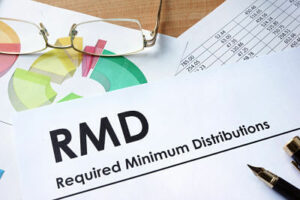RMDs – What, Why, and How Do They Work?
 RMDs are Required Minimum Distributions. These are required distributions from annuities like IRAs, 401(k), 403(b), or a 537.
RMDs are Required Minimum Distributions. These are required distributions from annuities like IRAs, 401(k), 403(b), or a 537.
Do you remember the movie Indiana Jones and the Last Crusade? There is a scene where Indy is fighting the bad guy while positioned on a tank as it drives towards and eventually over a cliff. Think of your money as the tank and the government as the driver. The government is essentially pushing your money over a cliff at age 70.5 and saying that you have to take this money out. You have deferred tax for too long and now it’s time to take some out so that we can tax it.
The RMD table is how they calculate how much you need to take out. The table shown below is the Uniform Lifetime Table, the most commonly used of three life-expectancy charts that help retirement account holders figure out mandatory distributions.
To calculate the year’s minimum distribution amount, take the age of the retiree on Dec. 31 of that year and find the corresponding distribution period. Then divide the value of the IRA by the distribution period to find the required minimum distribution.
So let’s look at an example of how the Uniform Lifetime Table is used. Pete Jones (no relation to Indy) is 71, a widower whose IRA was worth $500,000 at the end of last year. ULT indicates a distribution period of 26.5 years for a 71-year-old. Therefore, Joe must take out at least $18,867.92 this year ($500,000 divided by 26.5).
[table id=8 /]
Why Should I Care About RMDs?
RMDs are a big deal. What if you decide you don’t want to take out the minimum distribution? You are subject to a 50% penalty. 50%!! Let’s put actual numbers to that. For example, let’s say Pete Jones missed his RMD on that $500,000 in his IRA of $18,248.17. If Pete somehow missed taking that required distribution, he could owe the IRS a penalty of $9,433.96.
Don’t be like Pete.
Some RMD Basics You Should Know
- RMD’s are calculated across all personal retirement accounts if you are not currently working. So, let’s say you have multiple IRAs with an annuity, a brokerage account, and some bonds. The RMD is the aggregate of all three accounts. You can, however, take the necessary amount out of only one account to satisfy the total RMD for all three accounts.
- Employer-sponsored plans differ from IRAs in rules relating to aggregation. A person with multiple IRAs may add the balances in each account to determine the total RMD for the year, then take that full amount from a single IRA, or split it in any manner between two or more IRAs. However, employer-sponsored plans must remain distinct; the RMD calculation for each is performed separately, and the distributions must be taken from each plan individually. Exception: If the individual has more than one 403(b) tax-sheltered annuity account, the individual can total the RMDs and then take them from any one (or more) of the tax-sheltered annuities
- Employer-sponsored qualified retirement plans, such as 401(k) plans, require the same distributions that IRAs do. The beginning date requirement may be later than the date for IRAs. Although the rules require RMDs to begin by April 1 of the year after the individual reaches age 70.5, participants in an employer-sponsored plan can usually wait until April 1 of the year after retirement (if later than age 70.5) to begin distributions unless the individual owns 5% or more of the employer who is sponsoring the plan.
- At the end of each year, your investment and annuity accounts will send you the necessary tax documents, so when you file your tax return you can process and document the RMD correctly and verify it was taken.
- Unlike most distributions from IRAs and qualified plans, RMDs are never eligible for rollover; they must be withdrawn. Because the distributions are not rollover-eligible, however, taxes are not required to be withheld at the time of distribution, and may thus be postponed until the individual files a Federal Income Tax return for the year. Any amount withdrawn above the minimum required amount will be eligible for rollover within 60 days of the distribution. Income tax must be withheld from that portion of the rollover option is not elected.
It’s important to understand what is and is not possible when it comes to RMDs. If you have any questions, we’d love to hear from you!